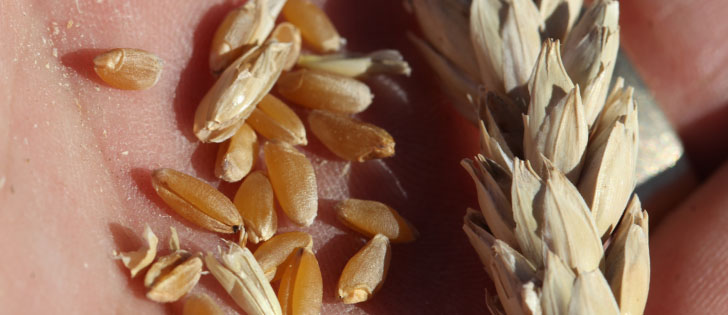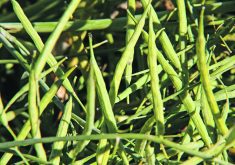FORT MACLEOD, Alta. – Pea and lentil growers are getting a new set of bugs.
But these they are going to pay for.
They are tiny rhizobial bacteria that need to populate pea and lentil roots to flourish, reproduce and fix nitrogen.
It is the last part that is important to pulse growers, and Becker Underwood has spent the past five years improving the technology, says company spokesperson Ralph deVries.
DeVries was in southern Alberta to show off Becker Underwood’s latest product, Nodulator XL. If the name sounds familiar, it should.
Read Also

Trump’s tariffs take their toll on U.S. producers
U.S. farmers say Trump’s tariffs have been devastating for growers in that country.
The company has used the name Nodulator for the past 15 years to describe several of its crop specific rhizobia inoculants.
“We have 171 station years of trial data on the new strain and we have seen a three to eight percent increase in yield over Nodulator and its competing brands,” said Danielle Fletcher, a Becker Underwood field agronomist in Lethbridge.
Nodulator for peas and lentils is based on rhizobium leguminosarum bv. viceae. So is the new inoculant, but the XL is a different strain, which took the company half a decade to move from discovery to registration.
DeVries said the new one turned out to be fussier and more demanding but also higher functioning.
“These animals were harder to breed in captivity,” he said.
“We had to develop some new approaches to get them from the lab scale to the point where we could make enough for plots and then to commercial scale production.”
Inoculants are living organisms and are required by federal regulation to be proven effective at performing whatever claims are made by the manufacturer.
In this case it is fixing nitrogen in peas and lentils.
“We had to find some new ways to keep this strain alive from manufacturing to field,” deVries said.
“We did manage it, but the P2 (the first Nodulator) strain was more forgiving than 1435 (the new XL version).”
Registration, which was achieved this spring, was contingent on the 1435 strain having the right population of rhizobia in the bags right through to the end of their best-before dates.
Increases in commodity prices have magnified the value of percentage increases in crop performance, and Becker Underwood’s three to eight percent increase in yield is worth $5 to $13 per acre in peas and $8 to $22 in lentils.
There are three application methods:
• liquid, which is applied to seed
• self adhering peat
• solid core, clay-type granule
Fletcher said the granule offered less dust and was more manageable than the peat product.
The new 1435 strain’s formulation also offers higher bug numbers in each package than its predecessor and as a result will require one-third as many bags to cover the same
number of acres, based on drill row spacing.
Becker Underwood will still offer its mini bulk bag distribution of the granule product, but it will have to lose the Q or Quarter Section Pack name because it will now cover more acres: up to nearly a half section with 12 inch row spacings.
DeVries said the product will be available for pre-season purchase this fall and timed for a spring delivery.
LETHBRIDGE – It pays to spray for sclerotinia when the crops are better than average and when the conditions are right.
Central to this is the presence of the disease’s inoculums and high humidity levels. Both are present in most areas of Western Canada this year.
“You need moisture ahead of bolting and then damp soils as the plants go into bolting,” said Murray Hartman of Alberta Agriculture.
“It doesn’t have to rain to cause problems. High humidity of 75 percent or so will do it.”
The tiny mushroom apothecia develops from a cagy sclerote that comes alive only when exposed to wet soils.
As well, it waits until it is shaded by the crop’s canopy before developing a new wave of spores capable of infecting the canola.
The canola leaves provide the necessary cover from daytime heat and wind so that the fungal bodies can go to work. This coincides with flowering’s start.
Staging of plants are highly variable across the West this year, with plants from four leaf to 50 percent flower, so spraying strategies can still benefit most producers’ fields, said Ed Thiessen of Syngenta.
“In areas that have seen the disease before, there is a real risk of it being there this year,” he said. “Conditions are about as favourable as it gets.”
Spraying is most effective between 20 and 50 percent flower, said Russell Trisha of BASF.
Hartman said it’s not difficult justifying spraying this year.
“You only need a 25 or 30 bushel crop to warrant going with an application this year due to the high prices,” said Hartman.
Thiessen said many seed growers have adopted split applications of fungicide to ensure they avoid large losses and get a cleaner crop.
“(I can see) in the future, with the high yielding hybrids and prices we are getting now, it is worth protecting … for many growers by moving to split applications ,” he said.
Some of the most recent canola hybrids are sclerotinia resistant, but while that reduces the chance of serious wreck, it doesn’t eliminate losses during years when disease pressure is at it heaviest.
Kristin Hacault of Pioneer Hi-Bred said it makes sense to spray higher potential canola crops, depending on the sclerotinia threat, field conditions and whether sclerotinia is known to be present.
Thiessen said growers need to evaluate their fields, particularly areas that have highly variable development, and aim to spray when there is moisture under the canopy and flowering is underway for the largest group of plants in the at-risk flowering stage.
“And not just when you can get an aerial applicator,” he said.
Hacault said resistant genetics add flexibility to the timing.
Some growers are applying a herbicide and a fungicide in a tank mix, but Thiessen said this can cause problems in the sprayer tank.
“Try to make sure that if you’re loading up the tank with herbicide, fungicide, micronutrients and other stuff that you aren’t adding to the stress of an already stressed crop or yours by gumming up the sprayer.”














